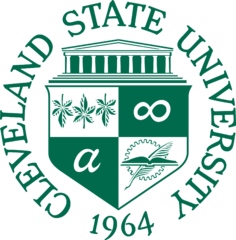
Cleveland State University (CSU) is a public research university in downtown Cleveland, Ohio, United States. It was established in 1964, and opened for classes in 1965 after acquiring the entirety of Fenn College, a private school that had been in operation since 1923. CSU absorbed the Cleveland-Marshall College of Law in 1969. Today it is part of the University System of Ohio, has more than 120,000 alumni, and offers over 200 academic programs. It is classified among "R2: Doctoral Universities – High research activity".
Old Post Office, or Former Post Office, may refer to:
Central High School may refer to a number of high schools:
St. Mary's School may refer to:
Central School may refer to:
Trinity High School is a private coeducational Roman Catholic college preparatory High School, located in Garfield Heights, Ohio, United States. It is located in the Roman Catholic Diocese of Cleveland. It was started in 1926 by the Sisters of St. Joseph of the Third Order of St. Francis.
St. Joseph's School, St. Joseph's Catholic School, St Joseph's School, St Joseph's Catholic School, and variants are frequently used school names, and may refer to:
Immaculate Heart of Mary, Sacred Heart of Mary, or variations with Church or School may refer to:
Jackson School may refer to:
A lyceum is a category of school in the education system of many countries.
Coburn & Barnum was a Cleveland, Ohio architectural firm from 1878 to 1897. It was established by Forrest A. Coburn and Frank Seymour Barnum. The firm also included W. Dominick Benes and Benjamin S. Hubbell for one year and was known as Coburn, Barnum, Benes & Hubbell until 1897, when Benes and Hubell departed to establish their own firm Hubbell & Benes. After their departure and Coburn's death, Barnum formed F. S. Barnum & Co. with Albert Skeel, Harry S. Nelson, Herbert Briggs, and Wilbur M. Hall. Barnum also served as consulting architect to the Cleveland Board of Education. He retired in 1915 having designed more than 75 school buildings, the Caxton Building (1903) and the Park Building (1904), an early example of reinforced concrete floor slabs. The firm continued after his 1915 retirement under the name of Briggs & Nelson.

Hubbell & Benes was a prominent Cleveland, Ohio architectural firm formed by Benjamin Hubbell (1857–1935) and W. Dominick Benes (1867–1953) in 1897 after the pair departed from Coburn, Barnum, Benes & Hubbell. Their work included commercial and residential buildings as well as telephone exchange buildings, the West Side Market and Cleveland Museum of Art. Before teaming up they worked for Coburn and Barnum. Benes was Jeptha Wade’s personal architect and designed numerous public buildings, commercial buildings, and residences for him including the Wade Memorial Chapel.

Abram Garfield was the youngest son of President James A. Garfield and Lucretia Rudolph Garfield, and an architect who practiced in Cleveland, Ohio.
Martin de Porres is a Peruvian Roman Catholic patron saint of mixed-race people and racial harmony, usually depicted holding a black scapular and capuce in iconography.
This page is based on this
Wikipedia article Text is available under the
CC BY-SA 4.0 license; additional terms may apply.
Images, videos and audio are available under their respective licenses.


